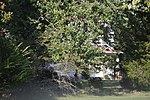Fort Gregg-Adams, in Prince George County, Virginia, United States, is a United States Army post and headquarters of the United States Army Combined Arms Support Command (CASCOM)/ Sustainment Center of Excellence (SCoE), the U.S. Army Quartermaster School, the U.S. Army Ordnance School, the U.S. Army Transportation School, the Army Sustainment University (ALU), Defense Contract Management Agency (DCMA), and the U.S. Defense Commissary Agency (DeCA).
Fort Gregg-Adams also hosts two Army museums, the U.S. Army Quartermaster Museum and the U.S. Army Women's Museum. The equipment and other materiel associated with the Army's Ordnance Museum was moved to Fort Gregg-Adams in 2009–2010 for use by the United States Army Ordnance Training and Heritage Center.
The installation was initially named Camp Lee (changed to Fort Lee in 1950) after Confederate States General, Robert E. Lee. It is one of the U.S. Army installations named for Confederate soldiers that The Naming Commission had recommended be renamed. On August 8, 2022, the commission proposed the name be changed to Fort Gregg-Adams, after Lieutenant General Arthur J. Gregg and Lieutenant Colonel Charity Adams Earley. On October 6, 2022 Secretary of Defense Lloyd Austin accepted the recommendation and directed the name change occur no later than January 1, 2024. On January 5, 2023 William A. LaPlante, US under-secretary of defense for acquisition and sustainment (USD (A&S)) directed the full implementation of the recommendations of the Naming Commission, DoD-wide. On April 27, 2023 the post was redesignated Fort Gregg-Adams.Fort Gregg-Adams is a census-designated place (CDP) with a population of 9,874 as of the 2020 census – nearly triple the size of the 2010 census count.








